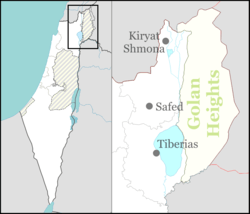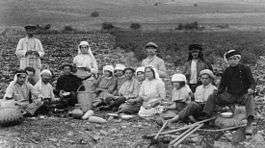Migdal, Israel
Migdal
| |
|---|---|
| Hebrew transcription(s) | |
| • ISO 259 | Migdal |
 Migdal | |
| Coordinates: 32°50′20.68″N 35°29′57.46″E / 32.8390778°N 35.4992944°ECoordinates: 32°50′20.68″N 35°29′57.46″E / 32.8390778°N 35.4992944°E | |
| District | Northern |
| Founded | 1910 |
| Government | |
| • Type | Local council (from 1949) |
| • Head of Municipality | Israel Sason Amrosi |
| Area | |
| • Total | 11,395 dunams (11.395 km2 or 4.400 sq mi) |
| Population (2015)[1] | |
| • Total | 1,812 |
| Name meaning | Tower |

Migdal (Hebrew: מִגְדָּל, lit. Tower) is a town in the Northern District of Israel. It was founded in 1910, and granted local council status in 1949. In 2015 it had a population of 1,812.
Migdal is located near Ginosar, and about 8 km north of Tiberias.[2] It has a shoreline on the Sea of Galilee, including the Tamar, Ilanot and Arbel beaches.
History
Migdal is built on the likely location of the classic era Magdala - a major Jewish town on the shores of the Lake of Galilee, which was destroyed during the First Jewish-Roman War in the 1st century CE.
In 1908, a small group of German Catholics who identified the site as the birthplace of Mary Magdalene settled there.[3] They left after a year and the land was bought by Russian Zionists who founded a farm, Ahuzat Moskva (Moscow Estate) in 1910. This settlement was adjacent to the Arab village al-Majdal. A few years later, the land was sold to private investors.[2] An encampment of Gdud HaAvoda workers who built the Tiberias-Rosh Pina road was established there in 1921.[4]
The town was named after the old city of Migdala Nunia (Aramaic: "fish tower"), home town of Mary of Magdala (Luke 8:2), and is situated just west of the Kinneret on Tiberias-Rosh Pina road.[2]
According to a census conducted in 1922 by the British Mandate authorities, Migdal had a population of 51 inhabitants, consisting of 42 Jews and 9 Muslims.[5]
Archaeology
In September 2009, a salvage dig of the Israel Antiquities Authority prior to the construction of a hotel revealed an ancient synagogue believed to date back some 2000 years, from 50 BCE to 100 CE. In the middle of a 120 sq.m. main hall, archaeologists discovered an unusual stone carved with a seven-branched menorah. It is the first of its kind to be discovered from the early Roman period. In addition to the engraved stone, the walls are decorated with brightly colored frescoes.[6]
Archaeologists have continued excavating and have found a mikveh which is, as of 2014, on public display.
References
<div class="reflist columns references-column-width" style="-moz-column-width: [2] [3] [6]; -webkit-column-width: [2] [3] [6]; column-width: [2] [3] [6]; list-style-type: decimal;">
- ↑ "List of localities, in Alphabetical order" (PDF). Israel Central Bureau of Statistics. Retrieved 16 October 2016.
- 1 2 3 4 5 6 About Migdal. Flags of the World
- 1 2 3 4 Ancient Menorah
- ↑ Encyclopedia of Zionism and Israel Herzl Press and McGraw-Hill,New York 1971, Volume II, p. 784
- ↑
- 1 2 3 4 Ancient Synagogue Found in Migdal
